
The Battle of Peleliu, codenamed Operation Stalemate II by the US military, was fought between the United States and Japan during the Mariana and Palau Islands campaign of World War II, from September 15 to November 27, 1944, on the island of Peleliu.
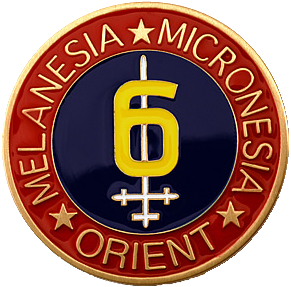
The 6th Marine Division was a United States Marine Corps World War II infantry division formed in September 1944. During the invasion of Okinawa it saw combat at Yae-Take and Sugar Loaf Hill and was awarded a Presidential Unit Citation. The 6th Division had also prepared for the invasion of Japan before the war ended. After the war it served in Tsingtao, China, where the division was disbanded on April 1, 1946, being the only Marine division to be formed and disbanded overseas and never set foot in the United States.

The 77th Sustainment Brigade is a unit of the United States Army that inherited the lineage of the 77th Infantry Division, which served in World War I and World War II. Its headquarters has been at Fort Dix, New Jersey, since its predecessor command, the 77th Regional Readiness Command, was disestablished in 2008 from Fort Totten, in Bayside (Queens), New York. Soldiers from the 77th have served in most major conflict and contingency operations since World War II.

The 1st Marine Division is a Marine division of the United States Marine Corps headquartered at Marine Corps Base Camp Pendleton, California. It is the ground combat element of the I Marine Expeditionary Force.

The 3rd Marine Division is a division of the United States Marine Corps based at Camp Courtney, Marine Corps Base Camp Smedley D. Butler and Okinawa, Japan. It is one of three active duty infantry divisions in the Marine Corps and together with the 1st Marine Aircraft Wing (1stMAW) and the 3rd Marine Logistics Group forms the III Marine Expeditionary Force. The division was first formed during World War II and saw four years of continuous combat in the Vietnam War. Today, elements of the 3rd Marine Division are continuously forward deployed and forward postured to carry out the US Government's mission of a Free and Open Indo-Pacific in conjunction with its sister services.

The 5th Marine Division was a United States Marine Corps ground combat division which was activated on 11 November 1943 at Camp Pendleton, California during World War II. The 5th Division saw its first combat action during the Battle of Iwo Jima in 1945 where it sustained the highest number of casualties of the three Marine divisions of the V Amphibious Corps. The 5th Division was to be part of the planned invasion of the Japan homeland before Japan surrendered. Assault troops of the 5th Division were included in the Presidential Unit Citation awarded to the V Amphibious Corps for extraordinary heroism on Iwo Jima from 19 to 28 February 1945. The 5th Division was deactivated on 5 February 1946.
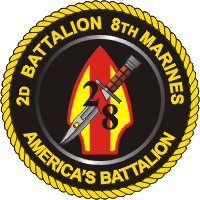
2nd Battalion, 8th Marines (2/8) is an infantry battalion in the United States Marine Corps based out of Marine Corps Base Camp Lejeune, North Carolina consisting of approximately 900 Marines and Sailors. Nicknamed "America's Battalion," they fall under the 8th Marine Regiment and the 2nd Marine Division.

1st Battalion, 4th Marines (1/4) is an infantry battalion in the United States Marine Corps based out of Marine Corps Base Camp Pendleton, California consisting of approximately 800 Marines and sailors. They fall under the command of the 1st Marine Regiment and the 1st Marine Division.

The 6th Marine Regiment is an infantry regiment of the United States Marine Corps based at Marine Corps Base Camp Lejeune, North Carolina. The regiment falls under the command of the 2nd Marine Division of the II Marine Expeditionary Force. Its combat history dates back to World War I when they were part of the American Expeditionary Force. They fought in the Pacific Theater in World War II, most notably at the battles of Guadalcanal, Tarawa, Saipan, Tinian and Okinawa. More recently, the regiment has seen combat during the Gulf War and in support of Operation Iraqi Freedom.

On 15 June 1944, United States Marine forces landed on the southwest coast of the island of Saipan in the central Marianas chain; these were followed a day later by US Army forces. This invasion was part of Operation Forager, an effort to recapture the entire Marianas chain from the Empire of Japan.

1st Battalion, 23rd Marines (1/23) is one of 32 infantry battalions in the United States Marine Corps, and one of only eight battalions found in the reserve. It is located throughout Texas and Louisiana consisting of approximately 1000 Marines and Sailors. They fall under the command of the 23rd Marine Regiment and the 4th Marine Division.

The 3rd Battalion, 9th Marines (3/9) is an infantry battalion of the United States Marine Corps. Formed during World War I it served until the early 1990s when it was redesignated as 3rd Battalion, 4th Marines (3/4) during a realignment and renumbering of the Marine Corps' infantry battalions, following the deactivation of the 9th Marine Regiment. The 3rd Battalion, 9th Marines was initially a subordinate unit of the 9th Marine Regiment, 3rd Marine Division, but was later operationally transferred to the 1st Marine Division as a subordinate unit of the 7th Marine Regiment where it remained until its redesignation as 3/4.
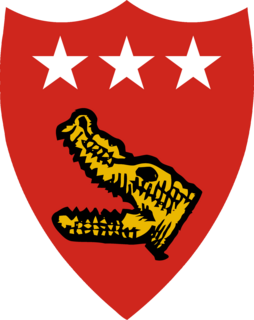
The V Amphibious Corps (VAC) was a formation of the United States Marine Corps which was composed of the 3rd, 4th and 5th Marine Divisions in World War II. The three divisions were the amphibious landing force for the United States Fifth Fleet with two goals, removal of Japanese forces from islands so U.S. Seabees could build advance bases to project US power. In doing this VAC was notably involved in the battles for Tarawa, Saipan, and Iwo Jima. V Amphibious Corps was commanded by General Holland 'Howlin Mad' Smith followed by General Harry Schmidt.
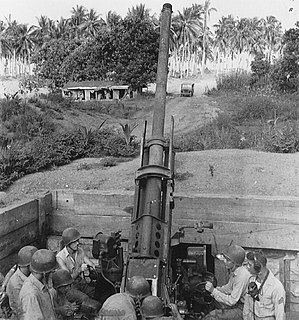
Marine Defense Battalions were United States Marine Corps battalions charged with coastal and air defense of advanced naval bases during World War II. They maintained large anti-ship guns, anti-aircraft guns, searchlights, and small arms to repel landing forces.

The 22nd Marine Regiment is an inactive United States Marine Corps infantry regiment. The regiment was commissioned in 1942 and was placed under the command of the 1st Provisional Marine Brigade, and the 6th Marine Division. It took part in fighting at the battles of Eniwetok, Guam, and Okinawa. The regiment also participated in the occupation of northern China following the war. 22d Marines was decommissioned in March 1946.
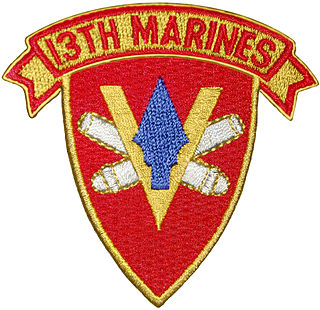
The 13th Marine Regiment was an artillery regiment of the United States Marine Corps. The regiment was activated for service three times during the 20th century when the Marine Corps expanded to meet war time requirements. Originally activated as an infantry regiment during World War I, the unit arrived in France before the war ended but did not participate in combat operations. It was reactivated for service in World War II as the artillery regiment for the 5th Marine Division. The unit saw intense combat during the Battle of Iwo Jima, participated in occupation duty in Japan and was quickly decommissioned shortly after the war. The regiment was last activated during the Vietnam War to again provide fire support for 5th Marine Division regiments supporting operations in South Vietnam. The regiment was finally deactivated on April 30, 1970, as the Marine Corps began to draw down its force structure at the conclusion of the Vietnam War.
The 2d Antiaircraft Artillery Battalion was a United States Marine Corps antiaircraft unit that served during World War II. Formed in 1940 as the 2d Defense Battalion, its original mission was to provide air and coastal defense for advanced naval bases. During the war the battalion defended Hawaii, Tutuila in American Samoa and Guam and took part in combat operations at Tarawa Atoll and Okinawa. The battalion returned to the United States after the war and was decommissioned at Marine Corps Base Camp Pendleton, California on 28 November 1945.

The 8th Antiaircraft Artillery Battalion was a United States Marine Corps antiaircraft unit that served during World War II. Formed in 1942 as the 8th Defense Battalion, its original mission was the air and coastal defense of advanced naval bases. During the war the battalion defended Tutuila in American Samoa, Wallis Island and Apamama and took part in combat operations at Okinawa. The battalion returned to the United States after the war and was decommissioned on 28 November 1945.
The 16th Antiaircraft Artillery Battalion was a United States Marine Corps antiaircraft unit that served during World War II. Formed in 1942 as the 16th Defense Battalion, its original mission was the air and coastal defense of advanced naval bases. During the war the battalion defended Johnston Island, Hawaii and Tinian and took part in combat operations at Okinawa. The battalion returned to the United States after the war and was decommissioned on 30 November 1945 at Marine Corps Base Camp Pendleton, California.
The 5th Antiaircraft Artillery Battalion was a United States Marine Corps antiaircraft unit that served during World War II. Formed in 1940 as the 5th Defense Battalion, its original mission was providing air and coastal defense for advanced naval bases. Prior to World War II the battalion deployed to Iceland as part of the 1st Provisional Marine Brigade in order to defend the neutral country from possible German attack. Following the Iceland deployment and a period of rest and refitting at home the battalion again deployed overseas to provide air defense for Funafuti in the Ellice Islands from September 1942 through February 1944. Also in 1942, two batteries from the 5th were dispatched to support operations on Tulagi during the Guadalcanal Campaign. These two batteries were later reorganized as part of the newly formed 14th Defense Battalion. The 5th Defense Battalion was re-designated as the 5th Antiaircraft Artillery Battalion in April 1944 and took part in the Battle of Okinawa in 1945. After the war the battalion returned to the United States where it was decommissioned in November 1945. Because the 14th Defense Battalion was formed from batteries belonging to the 5th Defense Battalion the two units retained close ties throughout the war. The 14th was nicknamed "Five:Fourteenth" and after the war the battalions formed a single alumni association.


















